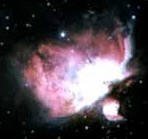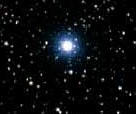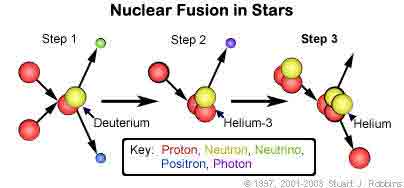|
       
> Star Formation
> Life and Death of a star
> Physical Description
> Star Catalogues
> Classification of Stellar Spectra
> Double Stars
> Variable Stars
> Neutron Star
> Black Holes
    
|
Stellar evolution
begins with a giant molecular cloud (GMC), also known as a stellar
nursery. Most of the 'empty' space inside a galaxy actually contains
around 0.1 to 1 particle per cm³, but inside a GMC, the typical density is
a few million particles per cm³. A GMC contains 100,000 to 10,000,000
times as much mass as our Sun by virtue of its size: 50 to 300 light years
across.
As a GMC orbits the galaxy, one of several events might occur to cause its
gravitational collapse. GMCs may collide with each other, or pass through
dense regions of spiral arms. A nearby supernova explosion can also be a
trigger, sending shocked matter into the GMC at very high speeds. Finally,
galactic collisions can trigger massive bursts of star formation as the
gas clouds in each galaxy are compressed and agitated by the collision.
A collapsing GMC fragments as it collapses, breaking into smaller and
smaller chunks. Fragments with masses of less than about 50 solar masses
are able to form into stars. In these fragments, the gas is heated as it
collapses due to the release of gravitational potential energy, and the
cloud becomes a protostar as it forms into a spherical rotating object.
 |
Great Nebula in Orion
A star begins life as a large, relatively cool
mass of gas, part of a nebula such as the Great Nebula in Orion |
This initial stage of stellar existence is almost invariably hidden away
deep inside dense clouds of gas and dust. Often, these star-forming
cocoons can be seen in silhouette against bright emission from surrounding
gas, and are then known as Bok globules.
Very small protostars never reach temperatures high enough for nuclear
fusion to begin; these are brown dwarfs of less than 0.1 solar mass. They
die away slowly, cooling gradually over hundreds of billions of years. The
central temperature in more massive protostars, however, will eventually
reach 10 megakelvins, at which point hydrogen begins to fuse into helium.
The star begins to shine. The onset of nuclear fusion sets up a
hydrostatic equilibrium in which energy released by the core prevents
further gravitational collapse. The star then exists in a stable state.
Maturity
New stars come in a variety of sizes and colors. They range in spectral
type from hot and blue to cool and red, and in mass from less than 0.5 to
more than 20 solar masses. The brightness and color of a star depend on
its surface temperature, which in turn depends on its mass.
 |
As gravity in a nebula causes the gas to
contract, its temperature rises, eventually becoming high enough to
trigger a nuclear reaction in its atoms. The shining of a
main-sequence star is caused by the steady output of vast amounts of
energy from the fusion of hydrogen nuclei to form helium. The
main-sequence phase of a medium-sized star is believed to last as
long as 10 billion years. |
A new star will fall at a specific point on the main sequence of the
Hertzsprung-Russell diagram. Small, cool red dwarfs burn hydrogen slowly
and may remain on the main sequence for hundreds of billions of years,
while massive hot supergiants will leave the main sequence after just a
few million years. A mid-sized star like the Sun will remain on the main
sequence for about 10 billion years. Once a star expends most of the
hydrogen in its core, it moves off the main sequence.
[Top]
Energy making during normal life
During the major part of their lives, most stars on the
Main Sequence will create their energy by the process of hydrogen fusion -
the process of fusing two hydrogen atoms to create one helium atom. Energy
is created because a helium atom weighs slightly less than the two
hydrogen atoms, and the excess mass is converted into energy, as related
by Einstein's famous equation E=m*c2. Our sun is
currently in this stage of converting hydrogen to helium.
In the picture below, two protons join together to form a deuterium
nucleus, which is also known as "heavy water." A positron and a neutrino
are released as by-products. The deut erium
nucleus is bombarded by another proton, creating a helium-3 nucleus. The
by-product of this is a photon in the form of a gamma ray (a very
high-energy form of light). Then, the helium-3 nucleus in bombarded by
another helium-3 nucleus, creating a normal helium-4 nucleus. The
by-product of this are two protons, which are free to start the whole
process over again. The positron will be destroyed and form another gamma
ray; the energy from this in the form of gamma rays is radiated out of
sun's core. erium
nucleus is bombarded by another proton, creating a helium-3 nucleus. The
by-product of this is a photon in the form of a gamma ray (a very
high-energy form of light). Then, the helium-3 nucleus in bombarded by
another helium-3 nucleus, creating a normal helium-4 nucleus. The
by-product of this are two protons, which are free to start the whole
process over again. The positron will be destroyed and form another gamma
ray; the energy from this in the form of gamma rays is radiated out of
sun's core.
Since our sun is currently in this stage, the numbers here are for it
alone, although since it is like most other stars, the are representative
of how all stars work. Each second, the sun converts 500 million metric
tons of hydrogen to helium. In turn, every second 5 million metric tons of
excess material is converted into energy. This means that every year,
157,680,000,000,000 metric tons are converted into energy. The material
from one second energy is about 1x1027 (one octillion thousand) watts of
energy. On Earth, we receive about 2/1,000,000,000 (two billionths) of
that energy, or about 2x1018 (two quintillion) watts. This is enough
energy to power 100 average light bulbs for about 5 million years --
longer than humans have been standing upright.
[Back] [Top] [Next] |


 erium
nucleus is bombarded by another proton, creating a helium-3 nucleus. The
by-product of this is a photon in the form of a gamma ray (a very
high-energy form of light). Then, the helium-3 nucleus in bombarded by
another helium-3 nucleus, creating a normal helium-4 nucleus. The
by-product of this are two protons, which are free to start the whole
process over again. The positron will be destroyed and form another gamma
ray; the energy from this in the form of gamma rays is radiated out of
sun's core.
erium
nucleus is bombarded by another proton, creating a helium-3 nucleus. The
by-product of this is a photon in the form of a gamma ray (a very
high-energy form of light). Then, the helium-3 nucleus in bombarded by
another helium-3 nucleus, creating a normal helium-4 nucleus. The
by-product of this are two protons, which are free to start the whole
process over again. The positron will be destroyed and form another gamma
ray; the energy from this in the form of gamma rays is radiated out of
sun's core.